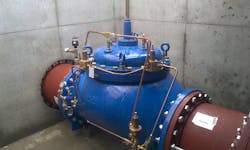Kansas Facility Finds Quick, Reliable Fix to Cavitation Damage
The Hutchinson, Kan., water plant gets its water from 20 wells. The water is pumped out of the wells and into a reverse osmosis (RO) water treatment center to purify and ensure safe drinking water. At that point, a portion of the water is taken off from the main line, run through the RO system and then mixed back with the well water. This is used to lower the total dissolved solids in the water. The plant can handle 10 million gallons per day (mgd) and provides water to 41,000 residents and businesses.
The Problem
When the plant was built in 2008, it was designed primarily for the large summer water demand and not the low winter demand. The original mixing butterfly valves were sized correctly for the summer demands, but in the lower-demand season (winter), it would mean dropping too much pressure across theses valves. With inlet pressure varying from 90 to 50 psi and outlet pressure at approximately 10 psi, the butterfly valves could not handle this variance in pressure without seeing severe cavitation and damage. The result was extreme noise from cavitation and valves that were failing to perform their job after just two years.
Cavitation is essentially rapid vaporization and condensation within a liquid. When local pressure falls to vapor pressure—approximately 0.25 psi (0.018 bar) absolute for cold water—vapor bubbles are formed, and when these bubbles travel to an area of higher pressure, the bubbles collapse with phenomenal force and great localized stress. The shock waves and pressure fluctuations resulting from these high-velocity bubble collapses can also cause noise, vibrations, accelerated corrosion and limited valve flow.
The Solution
There was some consideration of adding another smaller set of mixing butterfly valves for the winter water demand, but that would have involved piping modifications. This is when Todd Nason at Mid America Valve presented the idea that a pressure-reducing valve (PRV) with anti-cavitation trim in front of the plant would be the simplest, most reliable, most cost-effective solution. In this case, the PRV would take the main pressure drop while the mixing butterfly valves would be used for trimming the flow.
Nason worked with both Professional Engineering Consultants and the City of Hutchinson to look at all the flow options to make sure it would work and determine where to place the valve. The decision was made to go with a 20-in. Singer PRV (S106–PR-AC) because it has a single rolling diaphragm (SRD) that provides smooth, steady and precise pressure control from maximum to virtually zero flow. The effective area of an SRD remains constant so the bonnet is much smaller and lighter than a flat diaphragm. A measured quantity into the bonnet control chamber always gives the same smooth movement of the inner valve through the entire stroke. A smaller bonnet also makes the valve lighter and safer for maintenance, while the smaller control chamber enables it to respond faster to changing pressures. By eliminating the seat chatter at low flows (capable down to as low as 50 gal per minute), the SRD avoids injecting small pressure pulses into the piping which, over time, may increase leakage, losses or pipe bursts.
Mid-America Valve, along with Singer Valve, provided training and explanation of valve operation to a Hutchinson staff of six members. Areas covered were functions of the valve and preventative maintenance steps for the valve in its first year of service. These would include the checking and cleaning of the stainless steel strainer, exercising the ball valves, checking for and bleeding air from the pilot system and checking the tightness of all the fasteners, fittings and connections. This training helps to ensure that valves operate at maximum efficiency and prolongs the life of the valves with a regular maintenance schedule.
[Visit Singer Valve's W&WD Storefront]
The Results
“Once the new PRV was put in place, the unbearable sound from cavitation was no longer present, and we now have consistent reliable flow and pressure,” said Don Koci, superintendent of water systems.
Going forward, the city should not have to incur the costs of replacing the valving as before on an annual or biannual basis. This new valve is factory guaranteed for three years, and with maintaining an effective preventative maintenance program, the valve should operate for decades to come. This also provides further protection to other components on this section of the system, prolonging its life span as well.
